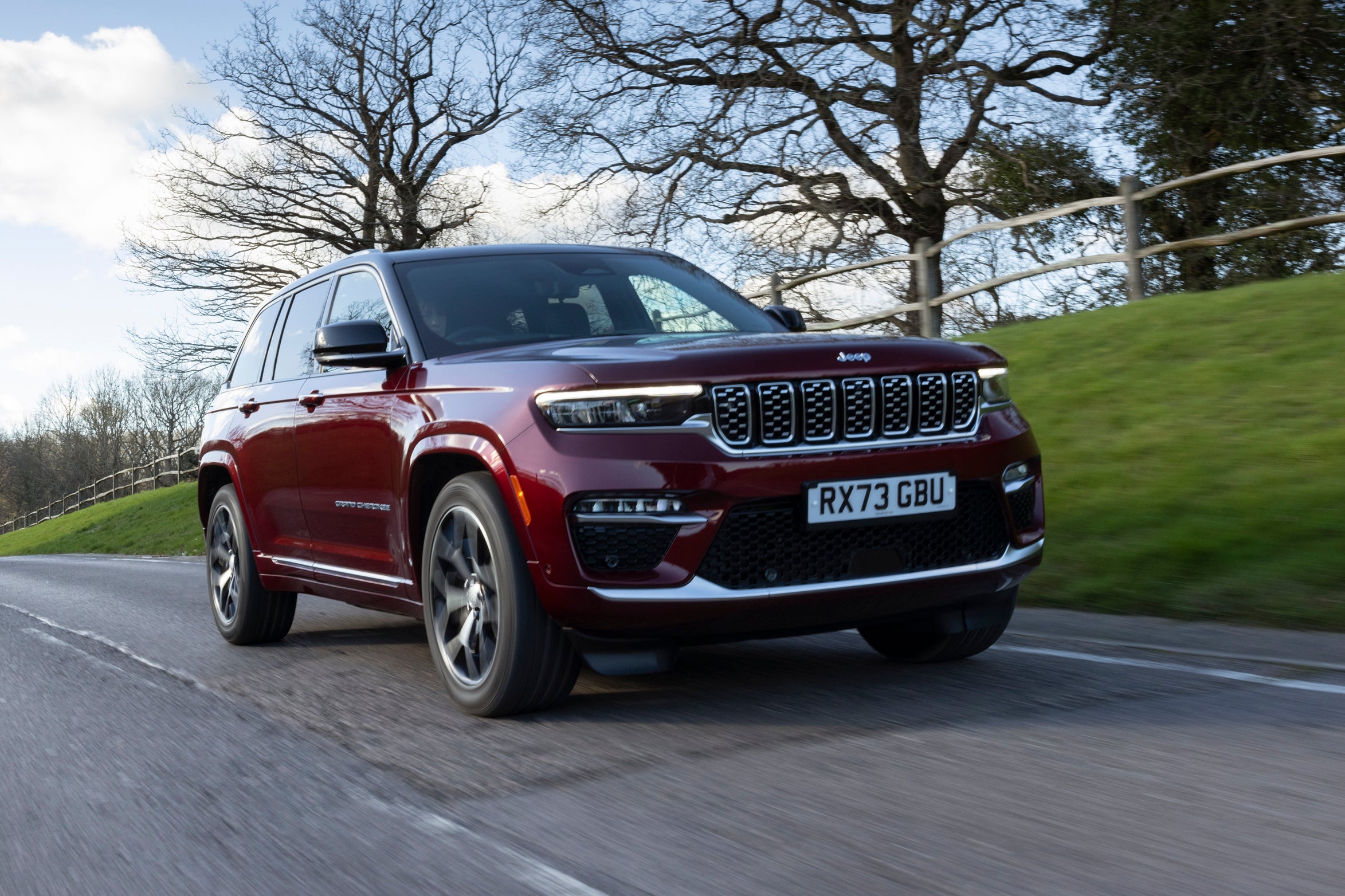Jeep Grand Cherokee Review 2025: Price, specs & boot space
Written by Al Suttie
Quick overview
Pros
- Very well equipped
- Off-road ability
- Hybrid drivetrain
Cons
- Costly to buy and run
- No seven-seat option
- Limited towing capacity
Overall verdict on the Jeep Grand Cherokee
"The fifth-generation Jeep Grand Cherokee is a huge step on from its predecessor and comes with petrol-hybrid power as standard. It's also generously fitted out, but it's on-road manners leave it trailing all of its main rivals in the luxury SUV sector."
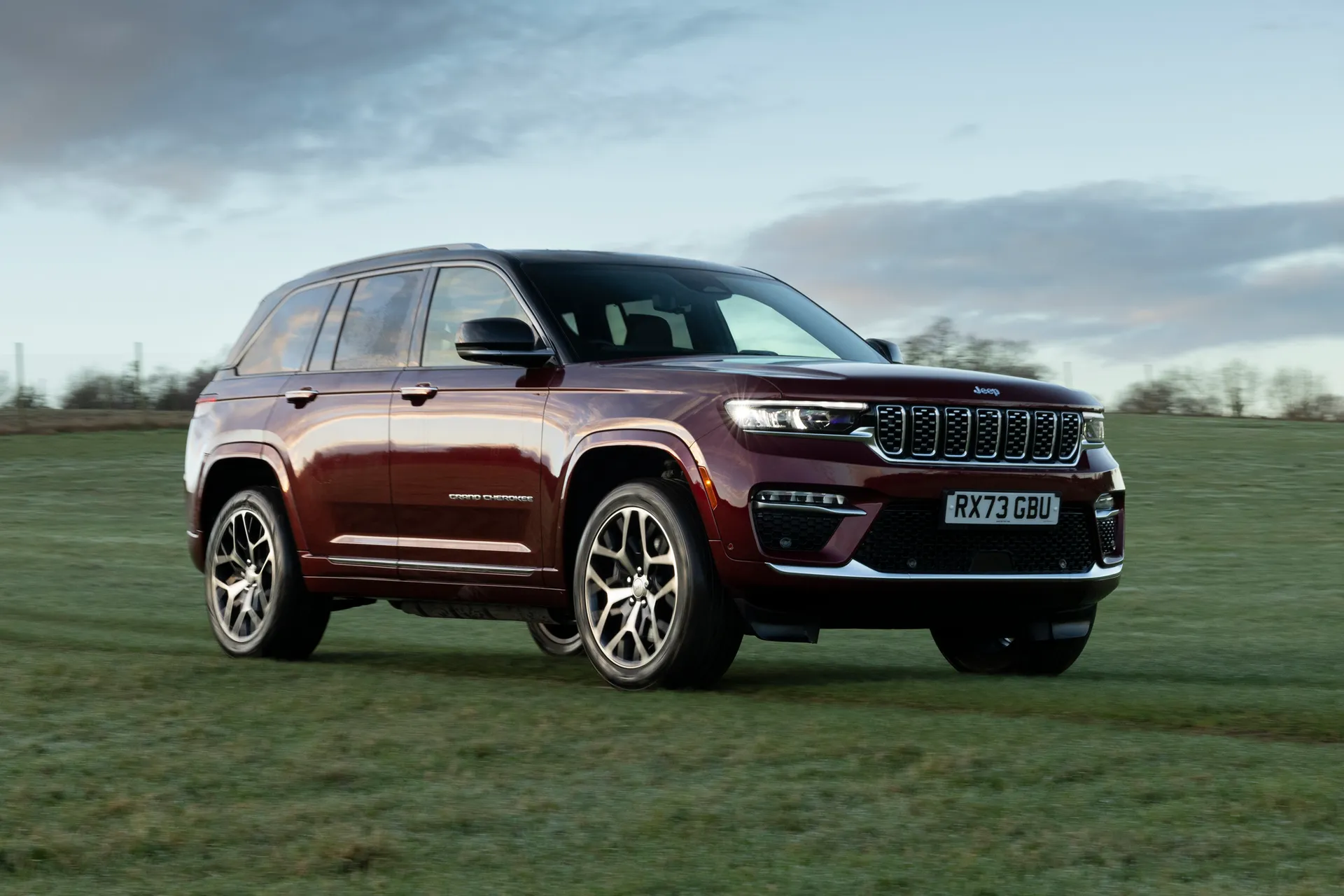
The Jeep Grand Cherokee has always offered a slightly different, transatlantic take on the luxury SUV idea for buyers on this side of the pond. For some, that's provided a welcome break from the majority of cars available in this opulent corner of the market. For others, the Grand Cherokee has been a bit too brash and not quite plush enough. This fifth-generation model strikes a better balance of those traits.
It's obvious from the restrained exterior styling that Jeep wants to mix it with the likes of the Audi Q7, BMW X5, Land Rover Discovery and Defender, Mercedes-Benz GLE, and the Range Rover Sport. A tough crowd to mix with, but one the Grand Cherokee takes on with glee.
As a Jeep, the Grand Cherokee's Land Rover-rivalling off-road ability is not in doubt thanks to its 4XE four-wheel drive system with various selectable modes for varying conditions. Only it and the Discovery, Defender and Range Rover Sport are truly go-anywhere cars in this segment. The Toyota Land Cruiser is too, but it doesn't cut it in the on-road luxury car stakes.
Back on terra firma and tarmac, the Grand Cherokee is a very decent car to drive. It rides well, steers well, and accelerates briskly. However, every rival listed above does all of these things either a bit better or a lot better. It leaves the Grand Cherokee as a car you have to want for other reasons.
Prime among those reasons could be its petrol-electric hybrid system. Where diesel has fallen out of favour in this sector and pure EVs are not offered by all manufacturers, hybrid still holds a strong appeal. With the Grand Cherokee, you get a 2.0-litre turbo petrol engine and two electric motors to deliver a total of 380PS.
That's a healthy dollop of power and see's the Jeep from 0-62mph in 6.3 seconds. You can also drive the car in petrol- or EV-only modes, or hybrid, using the selector buttons on the dash. In EV setting, Jeep claims the Grand Cherokee can cover up to 32 miles on battery power and it will drive at motorway speeds on electricity alone.
It all sounds very alluring, the four-cylinder petrol engine does not have the same refinement as the engines in its rivals. Nor does it deal with ragged roads as ably.
You don't get seven seats with the Jeep Grand Cherokee, either, which makes it sound like an also-ran. However, for the five people it can carry it is a very well appointed interior experience. Two trims are offer - Limited and Summit Reserve - and both come packed with screens, leather upholstery, and all the goodies you expect of this class. A disappointment, though, is the Jeep doesn't feel quite as well finished as others it's up against.
That is a theme with the Jeep Grand Cherokee where it's good but just misses out on bettering any of its rivals. As a package, it has some appeal, but it's quite pricey, can't tow as much as some, and isn't as good to drive.
If you're looking for the older version, you need our used Jeep Grand Cherokee (2011-2020) review
Is the Jeep Grand Cherokee right for you?
Anyone who covets the Jeep Grand Cherokee will be unmoved by rational arguments that its rivals make a better case. We get it as the Grand Cherokee is handsome outside and in, comes with a lengthy list of standard kit, and it can cope with serious off-road work.
The Jeep Grand Cherokee is also defined by what it's not - not another German upmarket SUV or Land Rover product. For some, that will be enough to convince them that different is worth certain trade-offs.
What's the best Jeep Grand Cherokee model/engine to choose?
'Go big' is the mantra for most Jeep Grand Cherokee buyers as they choose the Summit Reserve model over the less costly Limited. The £13,000 premium for the Summit Reserve brings a lot of extra kit that means the Grand Cherokee more than fulfils its brief as a luxury SUV, and it's even a fraction more economical than it sister model, so we'd go big too.
What other cars are similar to the Jeep Grand Cherokee?
The list of rivals to the Jeep Grand Cherokee reads like Who's Who of the SUV glitterati. First off, there are Jeep's old adversaries with the Land Rover Discovery and Defender, plus the Range Rover Sport. You also need to consider the German executive triumvirate of the Audi Q7, BMW X5, and Mercedes-Benz GLE, plus the Volkswagen Touareg, as well as the Italian offerings of the Alfa Romeo Stelvio and Maserati Grecale.
The Ineos Grenadier will appeal to anyone with image and off-roading in mind, while the Toyota Land Cruiser is also hugely able off-road. You might also look at the Hyundai Santa Fe or Kia EV9 and decide they offer a different take plus excellent warranty cover.
Comfort and design: Jeep Grand Cherokee interior
"Jeep has blended high tech with old-school luxury fittings very well inside the Grand Cherokee, but there's no seven-seat option."
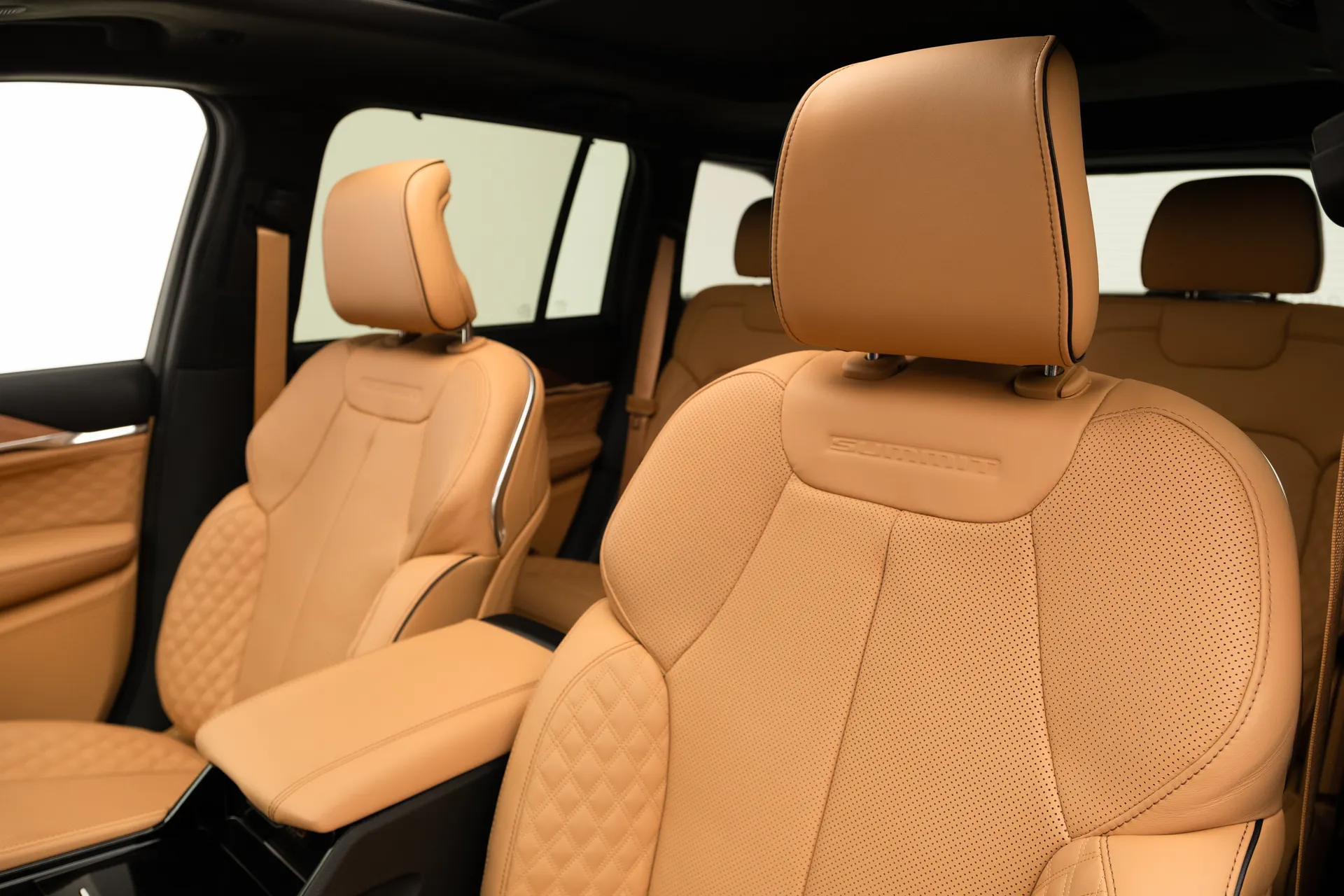
Open the driver's door of the Jeep Grand Cherokee and you step in rather than climb up as you might in generations past. This is a good thing as it makes the Grand Cherokee instantly more wieldy even if it's still a large car on the outside.
This translates in to lots of cabin space, too, which was not always the case with previous Grand Cherokees. The standard black leather upholstery is a little sombre, but wooden trim inserts give that old-world charm and sense of luxury.
In the Limited, you have heated and ventilate front seats, heated steering wheel, electric seat adjust with memory for the driver, and a rear-view camera. This isn't strictly necessary for a change in a modern car as the Jeep affords very good all-round vision and its boxy shape makes it easy for the driver to gauge when parking.
While there's not step up into the Jeep, it does provide that elevated driving position beloved of SUV drivers. The seating position is simple to tailor to anyone's size and shape, the steering wheel feels thickly padded, and the 10.25-inch dash screen is sharp and easy to read. The Summit Reserve model comes with a head-up display for the driver and additional information screen for the passenger above the glovebox.
We're not so convinced by the scattergun approach for where some of the physical buttons are placed. Still, it's good to have them for things like the heated seats and steering wheel, and climate control.
Quality and finish
We like the look of the Jeep Grand Cherokee's interior, but we're not fans of how it is put together. In a car costing half as much we'd accept some of the more flimsy plastics and occasional creaks from within the dash. But in a car costing this much? No, just no.
There is also just not the same degree of fit and finish that you get in a Mercedes, Audi, or Range Rover. It shows in the stitching of the Jeep's leather and the plushness of the hide itself - all of its feels a step behind the main rivals to the Grand Cherokee.
Infotainment: Touchscreen, USB, nav and stereo in the Jeep Grand Cherokee
You can have as many as four screens inside the Jeep Grand Cherokee if you opt for the top line Summit Reserve model, which most buyers do.
The screen-fest starts with the 10.25-inch dash display, which is very good and comes with a head-up display in the Summit Reserve. All Grand Cherokees have a 10.1-inch infotainment touchscreen that works with Apple CarPlay and Android Auto. It's good, though not great as it can be a breath too slow to react sometimes.
Grand Cherokee Summit Reserve buyers are also treated to another screen placed in front of the passenger above the glovebox. It's 10.25-inches across to show the sat-nav or driving camera views. More relevantly, it lets the passenger work the stereo on the move and they can use it to watch videos or play games without distracting the driver.
Space and practicality: Jeep Grand Cherokee boot space
Accessing the rear seats of the Jeep Grand Cherokee is just as easy as it is for those in the front. The doors open wide and the rear bench is positioned as the perfect height for adults to just step in and sit down. Even younger kids will find it easy to climb in, and there Isofix mounts for kiddy seats in the two outer chairs.
There is more than ample room for adults in the back of the Grand Cherokee and two will find it positively cavernous. A third adults will also happily be accommodated in the centre seat thanks its broad cushion and more foot space than in most of the rivals in this class.
A panoramic glass roof is fitted to all Grand Cherokees, so it feels very bright and airy in the back even with the black leather upholstery that's standard on all models.
Wander round to the back of the Jeep and the powered tailgate lift sup to reveal a boot with 520-litres of cargo space. That's decent, if not earth shattering, and it can be extended up to 2004-litres with the 60-40 split and tip rear seat folded down.
Unusually, the button to close the tailgate is place in the rear pillar, which makes it much easier to reach for many people instead of stretch up to the boot hatch itself. The load sill sits flush with the floor and there's storage under the floor for the hybrid system's charging cable.
As you will have gathered from us not mentioning it, there is no third row of seats in the Jeep Grand Cherokee. For some, that will be a deal breaker, but it's not the end of the world in this segment for many buyers.
Handling and ride quality: What is the Jeep Grand Cherokee like to drive?
"Jeep's clever 4XE four-wheel drive system makes the Grand Cherokee all but unstoppable off-road. On the road, it's not as sophisticated."

There is a lot that a large luxury SUV like the Jeep Grand Cherokee has to do and deal with to sit among the best in the segment. The Jeep gets off to an excellent start with its off-road prowess.
For anyone who needs true all-terrain ability, the Grand Cherokee is right there with the Land Rover Discovery and Range Rover Sport. A Defender or Jeep's own Wrangler are both even more able, but the Grand Cherokee will leave you open-mouthed at what it can do.
It's helped by Jeep's 4XE four-wheel drive set-up, which comes with a choice of five road heights in the Summit Reserve models thanks to its air suspension system. All Grand Cherokees have selectable off-road modes for snow, rocks, mud and sand.
Turning back on to normal roads, the Grand Cherokee may be a large SUV, but it feels surprisingly compact compared to an Audi Q7. This is partly down to its raised driving position and square shape that makes it easy to judge in tighter spaces, and the Jeep is simple to park.
In town, it does an able job of smothering lumps and bumps, and it's a similar story on the motorway where it's happy to cruise in a very civilised fashion.
On country lanes and through roundabouts, you will notice more body lean in the Jeep than in a BMW X5 or Range Rover Sport. You'll also find the Grand Cherokee's steering doesn't deliver as much information or feel as these rivals'. In other words, it feels like a large SUV, whereas these competitors are superbly composed for this class.
What engines and gearboxes are available in the Jeep Grand Cherokee?
Whichever of the two trims you choose with the Jeep Grand Cherokee, both comes with the same petrol hybrid set-up. It's based around a 2.0-litre turbo petrol engine that works with a pair of electric motors to deliver a combined 380PS.
That sort of power allows the Jeep Grand Cherokee to cover off 0-62mph in 6.3 seconds and hit a top speed of 130mph. Neither figure will worry the quickest in this sector, but they are both more than sufficient for everyday driving as the Jeep can get past slower traffic quickly and safely.
Left to its own devices, the hybrid system will choose the most efficient mode to drive in at any given time. As a result, it can switch between, petrol, EV or a combo of the two. Or, the driver can use buttons on the dash to choose hybrid or EV settings, or a brake regenerations mode to charge up the battery on the move to make sure there's enough fizz for later use in town.
All of this drives through an eight-speed automatic gearbox that is smooth to shift gears and deals with the powertrain's 637Nm of shove very capably.
Refinement and noise levels
You won't find many cars that are more quiet when being driven off-road than the Jeep Grand Cherokee. Its supple suspension filters out most surfaces and damps away rocks and ridges.
When driving in town or even up to motorway speeds in EV mode, the Grand Cherokee is also very hushed. However, if you floor the accelerator pedal for full forward thrust, the petrol engine will come into play and gets very vocal at the upper end of its rev band.
When driven in hybrid or petrol-only modes, the 2.0-litre engine is generally not noisy, though you can hear it in the background. It's only when the engine is asked to work hard that it becomes coarse.
As for wind and tyre noise, they are both kept admirably at bay, so overall the Jeep Grand Cherokee is very refined unless being driven hard in a way that feels counter to its normal laid back demeanour.
Safety equipment: How safe is the Jeep Grand Cherokee?
Jeep earned a very solid five-star rating from Euro NCAP when the Grand Cherokee was tested. It puts the Jeep right alongside its main class rivals for safety performance in a crash.
Helping the Grand Cherokee to this result, all models come with front, side, curtain and driver's knee airbags, automatic emergency braking, fatigue alert, lane assist and departure warning, blind sport assistance, and traffic sign recognition. They also have a rear parking camera, automatic headlights, adaptive cruise control, and cross traffic alert.
Upgrade to the Summit Reserve model and you further enjoy a head-up display for the driver, 360- degree parking camera view, active driving assist system, and night vision with pedestrian and animal recognition.
MPG and fuel costs: What does a Jeep Grand Cherokee cost to run?
"Keep the battery charged up, use the EV mode as much as possible, and the Jeep Grand Cherokee claims up to ."97.4mpg."
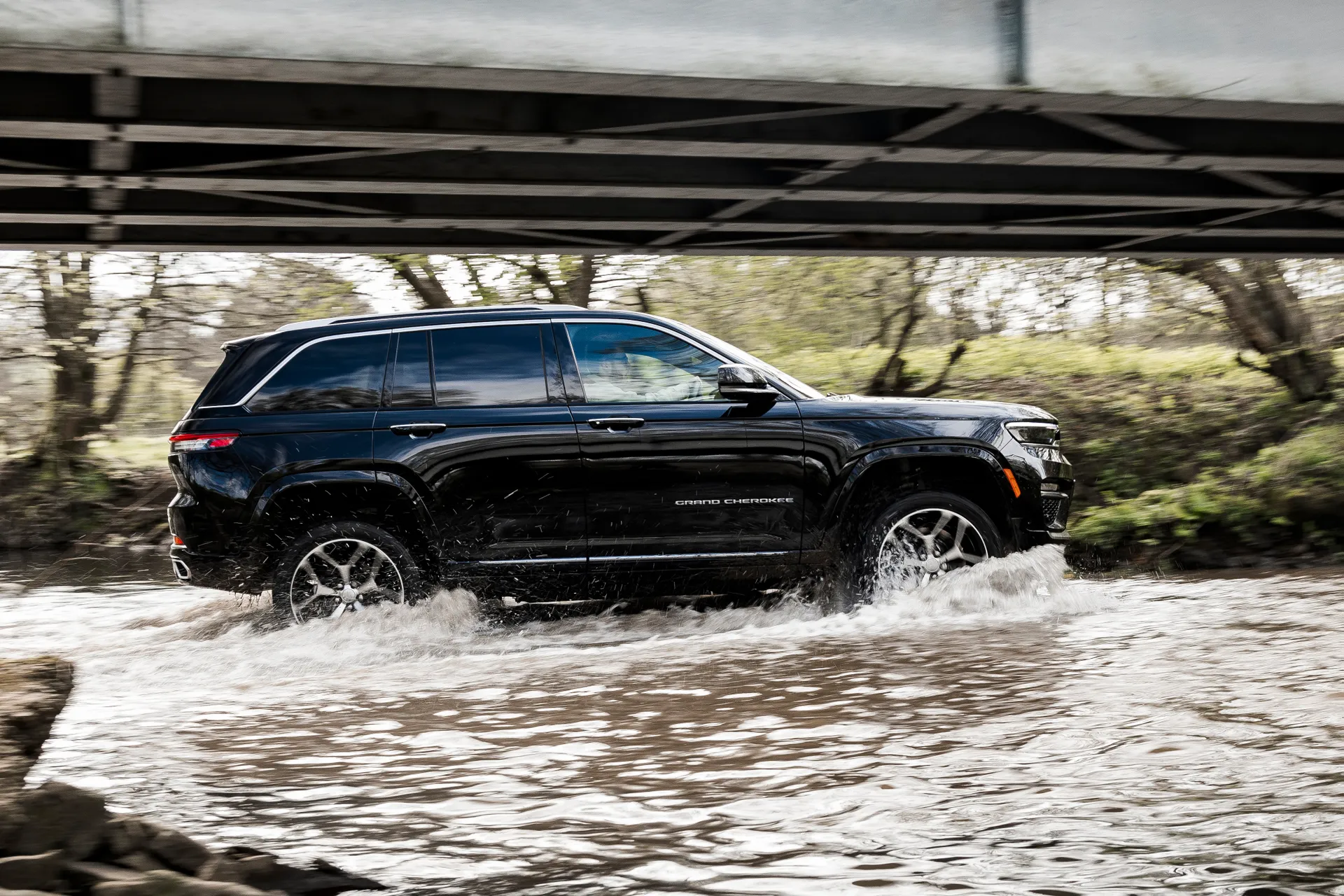
Downsizing to the 2.0-litre petrol engine with hybrid assistance has allowed Jeep to turn in come very commendable fuel economy figures for the Grand Cherokee. Make the most of its hybrid abilities and it's claimed the Limited is capable of 88.3mpg. The Summit Reserve betters that with 97.4mpg.
Bear in mind that to get near these figures you will have to charge the battery regularly and use the EV running mode as often as you can.
Jeep Grand Cherokee reliability and warranty
Jeep offers the Grand Cherokee with its usual three-year, 60,000-mile warranty cover. The hybrid system's battery is covered by a separate eight-year, 100,000-mile warranty
Jeep Grand Cherokee insurance groups and costs
Given the Jeep Grand Cherokee is a large, luxurious SUV with a list price that starts north of £70,000, you don't need to be Magnum PI to work out it will be at the higher end of the insurance spectrum. Pick the Limited model and it sits in group 48 (out of 50), while the Summit Reserve is in group 49.
VED car tax: What is the annual road tax on a Jeep Grand Cherokee?
You're probably dreading this section if you're in the market for a Jeep Grand Cherokee and have previously owned one of the older generation models. Fear not, carbon dioxide emissions of 71- and 65g/km for the Limited and Summit Reserve versions, respectively, mean you only pay £130 in the first year and £195 subsequently.
You're not quite out of the financial woods, though, as the Jeep Grand Cherokee's list price means you'll also be forking out he £410 expensive car supplements till it passes it fifth birthday.
Jeep Grand Cherokee price
"The Jeep Grand Cherokee looks like decent value, but it has a smaller EV range than most rivals."
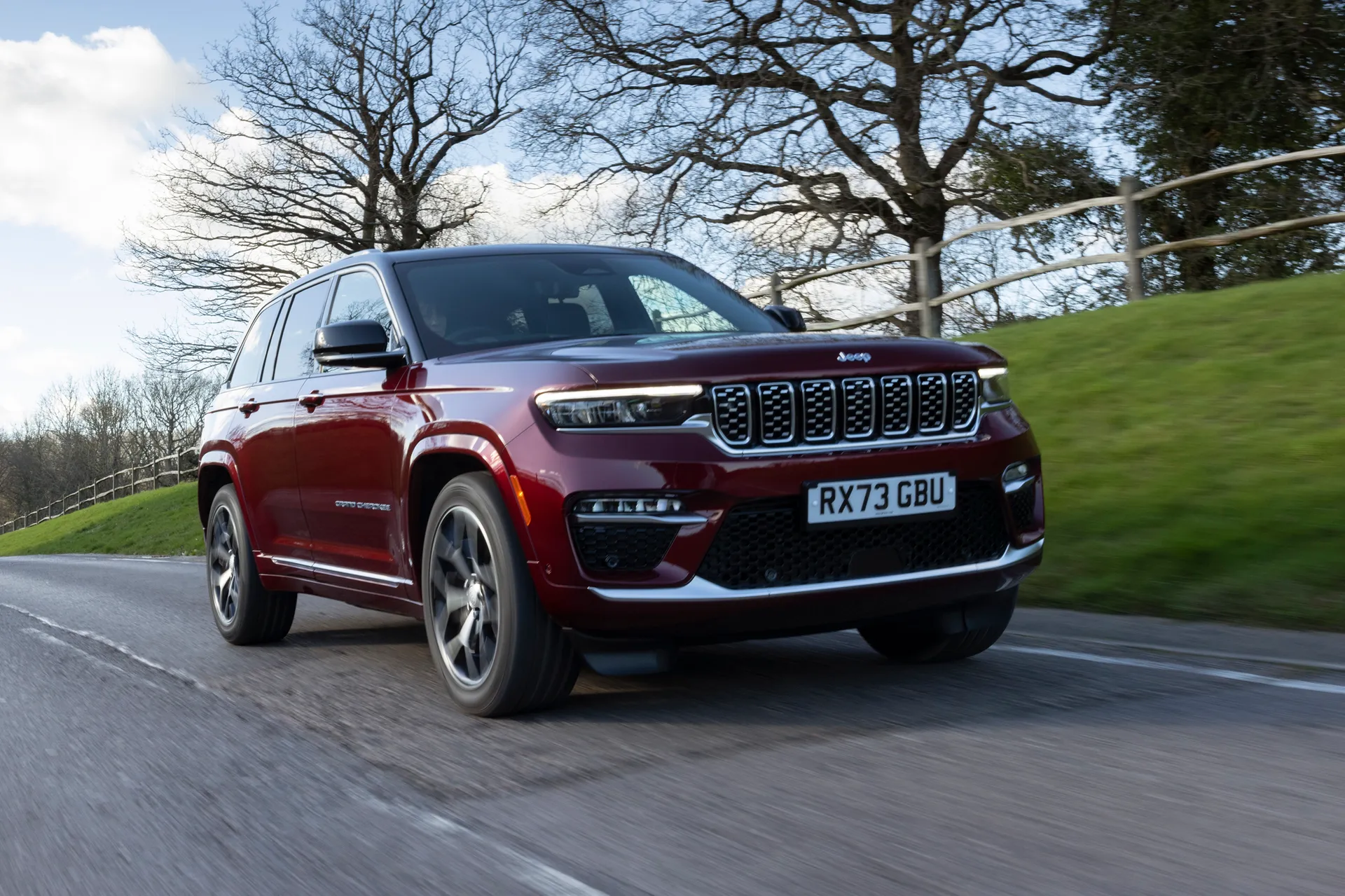
The £72,300 list price for the Jeep Grand Cherokee Limited is around £5000 less than you will pay for a similar model from Audi or Mercedes-Benz. Opt for the Jeep in Summit Reserve specification and it comes in at £85,800, which still appears keenly pitched against a Range Rover Sport P460e.
While the Jeep is well equipped in both trims, it must also be remembered its 32-mile maximum EV range is around half that of its key rivals. If you are a business user looking to reduce running costs, this is a crucial difference.
Trim levels and standard equipment
Jeep gets the Grand Cherokee range going with the traditional Limited trim, but there's nothing restricted about this model's equipment count. As standard, it comes sitting on 20-inch alloy wheels and finished in an attractive metallic red paint. You also get rear privacy glass, panoramic glass roof and roof bars, reversing camera and parking sensors, powered tailgate, keyless entry and ignition, and chrome exterior trim.
Inside, the Limited has Capri vynil man-made leather upholstery, heated and ventilated front seats, heated steering wheel, climate control, memory function for the driver's seat and electric adjustment for both front chairs. There's also the 10.25-inch driver's dash cluster, 10.1-inch infotainment screen, adaptive cruise control, automatic headlights and wipers, and a wireless phone charging pad.
Head on up to the Summit Reserve and you gain 21-inch alloy wheels, chrome exhaust tips, black-painted roof, and platinum-finish exterior trim. This model also has the Quadra-lift air suspension, park assist, electronic rear limited slip differential, and active noise control to make the cabin quieter.
Also part of the Summit Reserve's spec is 16-way electric movement for the front seats and massage function, heated rear seats, wood trim inserts, and LED ambient lighting. This model also has a 360-degree view parking camera, active driving assistance, remote tailgate opening, head-up display and passenger's info screen, and a 19-speaker McIntosh stereo system.
Ask the heycar experts: common questions
What are the main alternatives to the Jeep Grand Cherokee?
Is the Jeep Grand Cherokee a plug-in hybrid?
Can a luxury SUV really be good off-road?
Get our latest advice, news and offers
Keep me updated by email with the latest advice, news and offers from heycar.
By submitting you agree to our privacy policy
